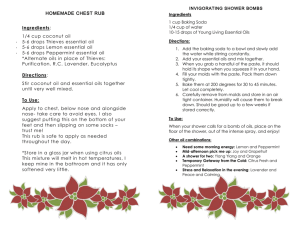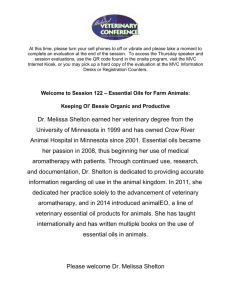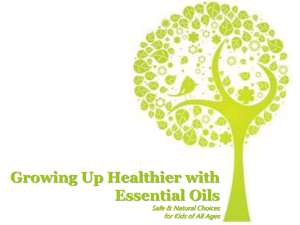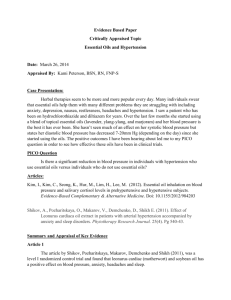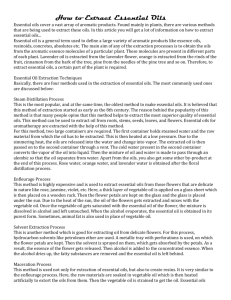lesson 4 - LogisticsMeds
advertisement
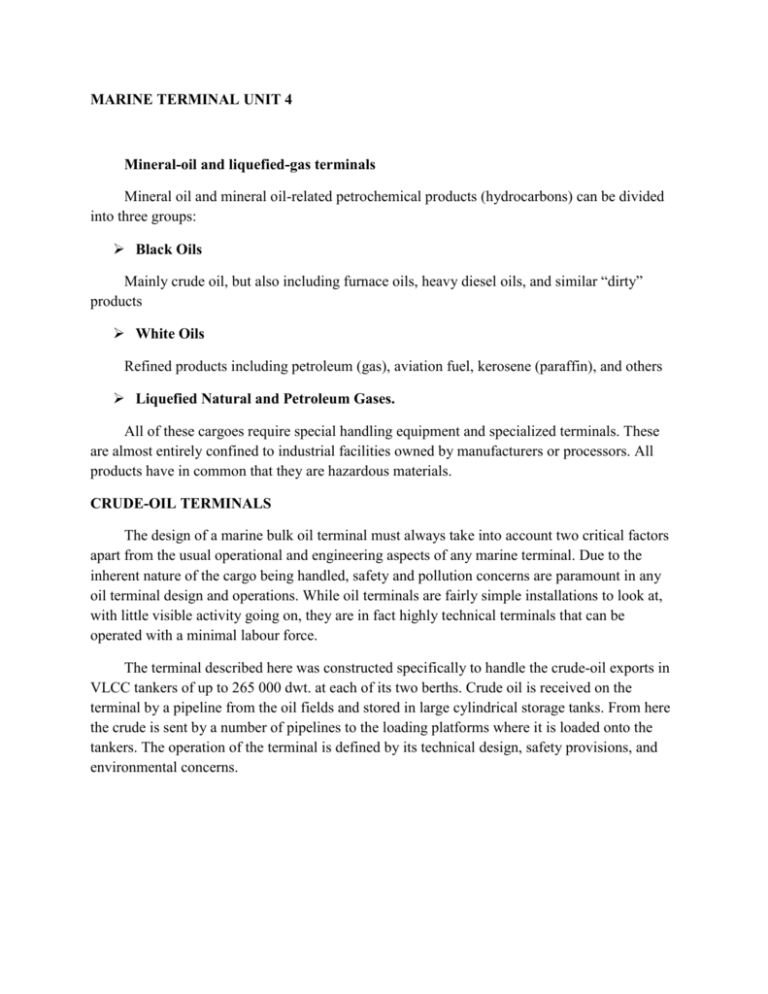
MARINE TERMINAL UNIT 4 Mineral-oil and liquefied-gas terminals Mineral oil and mineral oil-related petrochemical products (hydrocarbons) can be divided into three groups: Black Oils Mainly crude oil, but also including furnace oils, heavy diesel oils, and similar “dirty” products White Oils Refined products including petroleum (gas), aviation fuel, kerosene (paraffin), and others Liquefied Natural and Petroleum Gases. All of these cargoes require special handling equipment and specialized terminals. These are almost entirely confined to industrial facilities owned by manufacturers or processors. All products have in common that they are hazardous materials. CRUDE-OIL TERMINALS The design of a marine bulk oil terminal must always take into account two critical factors apart from the usual operational and engineering aspects of any marine terminal. Due to the inherent nature of the cargo being handled, safety and pollution concerns are paramount in any oil terminal design and operations. While oil terminals are fairly simple installations to look at, with little visible activity going on, they are in fact highly technical terminals that can be operated with a minimal labour force. The terminal described here was constructed specifically to handle the crude-oil exports in VLCC tankers of up to 265 000 dwt. at each of its two berths. Crude oil is received on the terminal by a pipeline from the oil fields and stored in large cylindrical storage tanks. From here the crude is sent by a number of pipelines to the loading platforms where it is loaded onto the tankers. The operation of the terminal is defined by its technical design, safety provisions, and environmental concerns. Technical design The technical design deals with the physical requirements of transferring the crude oil from the pipeline to either storage tanks or into the tankers and the infrastructure that is necessary to support this activity. To understand the technical design aspects it is necessary to break the terminal down into its critical operational functions. Pipeline The pipeline is the terminal’s link to the oilfields. The ease with which pipelines can be constructed enables the terminal to be located away from populated areas at a site that is suitable for large tankers. Storage facilities The storage facilities are an important part of the terminal operation. It is here that the crude oil is received through the pipeline from the oilfields. As the terminal handles only one product, crude oil, the dedicated storage tanks have capacity to hold about four times the largest shipload exported from the terminal. On this basis the total capacity of the storage tanks would be about eight million barrels of crude oil. The terminal has eight large semi-underground tanks built into a 60-metre (200-ft.) hill. The tanks are placed mostly underground for two reasons. Firstly, this method will ensure that the terminal will remain as inconspicuous as possible to an outside world concerned with the natural beauty of the coastline. Secondly, from a purely technical point of view, the ground acts as part of the structural support maintaining the integrity of the tanks This permits the storage capacity to be concentrated into a smaller number of tanks rather than the larger number that would be required for free-standing structures. The storage tanks are not equipped with a vapour-collection system, as this is found only in lighter, refined oil products such as gasoline. They are however equipped with floating roofs that move up and down depending on the amount of oil that is stored inside. These roofs prevent vapour from forming, evaporation to the air, and contamination of the oil by rain. While the storage tanks are linked to the pump house, they are also linked to one another so that oil can be transferred from one tank to another. The tanks must be emptied occasionally for cleaning and maintenance. Pumphouse and Loading Pipelines The storage tanks are connected to the pumphouse. Storage tanks can provide a gravity fed loading rate of about 40 000 barrels per hour (6 400 m3⁄ h), however this is too slow for large tanker operations. The pumphouse contains two large centrifugal pumps that move the oil among the tanks or out to the ships for loading. The pumps can boost the loading rate to about 150 000 barrels per hour (24 000 m3⁄ h). Loading pipelines are 48 inches (1.22 m) in diameter, and there are three pipelines dedicated to each loading platform. The actual pipes are constructed of high-grade steel and are frequently pressure checked. There are a number of pressure relief valves in the pipeline system to ensure that the maximum allowable pressure is not exceeded. Jetty construction The jetty is of a fairly simple construction consisting of a combined walkway/pipeway connecting the two loading platforms. There are no facilities to service ships, with the exception of freshwater supply, and the loading platforms are just large enough to accommodate the piping and other mechanical equipment, fire protection devices and personnel access. The jetty design takes a number of factors into consideration, including the approach speed of the ship, the angle of approach, and the fender design. The berthing structures are designed to withstand the impact of a fully loaded 265 000-dwt. tanker, provided that the angle of approach is at a prescribed 7.1 degrees. The angled approach is important because the jetty is far more able to withstand an impact along its broad face than head on. All offshore structures are concrete deck slabs on steel girders supported by open-ended steel pipe piles. Each loading platform has a berthing fender, along with a number of mooring dolphins. Access to the mooring dolphins is by a small catwalk. The fendering system consists of rubber compression blocks attached to fender piles. Loading System The loading system uses loading arms that are far more durable and therefore safer than flexible loading hoses. The loading arm must be flexible enough to take into account the movement of a vessel relative to the loading platform. The loading arms are elevated to be level with the ship’s manifolds. They are power operated as they are too large to be handled manually. A freshwater line is also available for use of the vessel being loaded. The loading operations are monitored constantly from the central control house. There is a slop-collection system in place on the loading platform to collect any spillage from draining the loading arms, contamination of rainwater, or accidental spillage from other sources. The loading area is surrounded by a liquid-tight curb to facilitate the collection of any oil. The slops are sent back to the shore to slop reclamation tank for eventual return to the pipeline. The ballast that is unloaded while a vessel is taking on crude is also sent on shore to an oily water separation plant. Berthing The berths and the seaward approaches have to have sufficient water to accommodate tanker drafts of up to about 24 metres. Three large tugs are required at the site, with at least two at the terminal at all times. They serve in the dual role of docking tugs and emergency response vessels for firefighting and pollution control. Two tugs are normally required to berth the very largest tankers, with the third being held in reserve. In the case of an emergency, additional tugs may be obtained from other terminals. A crude-oil terminal would require a specific berthing plan for a VLCC. For example: 1. One bowline and one stern line. A bowline is attached at the bow and leads forward from the ship to the dock. A stern line is attached at the stern and leads aft from the ship to the dock. They prevent the ship moving forward or astern and are run along the dock as far as practical so that only a little slack has to be left to allow for the rise and fall of the tide. 2. Forward breast lines and two after breast lines. Breast lines are short lines run out at right angles to the vessel and dock to stop the ship moving sideways in the berth. A forward breast line is attached somewhere forward of the midpoint of the ship, an after breast line somewhere aft of the midpoint of the ship 3. One forward spring line and one after spring line. A forward spring line leads forward from the ship to the dock, similar to a bowline, but shorter. A forward spring line can be attached anywhere along the ship. Forward spring lines attached to the bow, or somewhere near the bow, are forward bow spring lines; forward spring lines attached to the stern, or somewhere near the stern, are forward stern spring lines; others are known just as forward quarter spring lines. An after spring line leads aft from the ship to the dock, similar to a stern line, but shorter. An after spring line can be attached anywhere along the ship. After spring lines attached to the bow, or somewhere near the bow, are after bow spring lines; after spring lines attached to the stern, or somewhere near the stern, are after stern spring lines; others are known just as after quarter spring lines. In addition, emergency fire wires are required by law for towing the ship off the berth in case of a fire. These are positioned both on the offshore bow and quarter of the ship and the eyes maintained at or about the waterline at all times. Refined Oil-Product Terminals Most of the general principles of crude-oil terminal design also apply to the cleaner refined-oil products. Avoiding cross-contamination of pipelines and storage facilities is important, and separate sets of handling equipment may be necessary for each group of oils, or even for each separate product. The nation's crude oil pipelines transport crude oil from oilfields to refineries where the oil is turned into dozens of useful products such as gasoline, home heating oil, jet fuel, diesel, lubricants and the raw materials for fertilizer, chemicals and pharmaceuticals. Products pipelines then transport refined products to terminals or local distribution centers. Refined products are then distributed to the companies and consumers who rely on a steady and economically transported supply of these products. Most gasoline and diesel fuel supplies are delivered to the marketplace by pipelines from refineries to local distribution centers. Tanker trucks carry gasoline only the last few miles of the trip to individual service stations. Major airports rely almost entirely on pipelines, and have dedicated pipelines to deliver jet fuel directly to the airport. Almost all plastics are made from resins and other raw materials derived from oil. From our office desks to children's toys, we touch some sort of petroleum-based product almost every moment of our day. There are approximately 95,000 miles nationwide of refined products pipelines. Refined products pipelines are found in almost every state in the U.S., with the exception of some New England states. These refined product pipelines vary in size from relatively small 8 to 12 inch diameter lines up to 42 inches in diameter. Liquefied-Gas Terminals Liquefied natural gas (LNG) is transported at approximately atmospheric pressure at a very low temperature (−161ºC). Liquefied petroleum gas (LPG) is transported under high pressure. A wide variety of complex equipment is required for the liquefaction, storage, refrigeration, loading, unloading, and regasification of liquefied hydrocarbon gasses. Natural Gas Pipelines Natural gas is found in many of the same areas of the country as crude oil and is collected through small gathering systems and moved to gas processing plants, where impurities are removed. There are about 20,000 miles of natural gas gathering lines. The gathering lines move natural gas to large cross-country transmission pipelines. Including both onshore and offshore lines there are approximately 278,000 miles of natural gas transmission lines. Natural gas, unlike oil, is delivered directly to homes and businesses through local distribution lines. Large distribution lines, called mains, move the gas close to cities. These main lines, along with the much smaller lines to homes and businesses, deliver natural under streets in almost every city and town and account for the vast majority of pipeline mileage in the U.S. – 1.8 million miles. Safety Provisions The safety provisions on a terminal handling liquid hydrocarbons are primarily centred on safety through fire prevention, fire protection, and emergency egress. Fire prevention Fire prevention is where most of the safety effort on the terminal is concentrated. Maintenance of terminal equipment is a high priority, one that ensures that potential fire hazards, such as leaking pipes, never have a chance to develop. Hydrocarbons are not a hazard when properly contained and a safe pier is used designed to standards that limit leaks and failures. This includes minimizing pipe connections and using welded pipe rather than flanges when a connection is required. All pipes are annually tested hydraulically to a pressure of 1.5 times their maximum working pressure. How safe are Pipelines? The environmental and safety record of oil pipelines is excellent. Pipeline systems are recognized as both the safest transportation mode and the most economical way of distributing the vast quantities of oil from production fields to refineries and from refineries to consumers. Oil pipelines are usually the only feasible way to transport significant volumes by land over long distances. Without pipelines, our streets and highways would be overwhelmed by the trucks trying to keep up with the nation’s demand for petroleum products. The safety performance of the oil pipeline industry has improved substantially over the last 30 years with even greater gains in the last few years. All oil pipelines together had 129 spills larger than 50 barrels (2100 gallons) last year (2001 data year). Deaths and injuries resulting from oil pipeline transportation are very rare but do occur occasionally. LIQUID CHEMICAL TERMINALS A few liquid chemicals are carried in bulk. These include principally phosphoric acid, an important component of fertilizers, and liquefied ammonia. Many bulk liquids that are shipped in smaller volumes are handled through commercial terminals, both public and private. They are loaded on both conventional general cargo vessels and container ships. The loading and discharge of liquid-bulk cargoes is usually under the control of the surveyors, shipper, and steamship company representatives. The terminal may not be involved in this operation. Usually, the terminal receives the cargo as delivered by the delivering carrier and assigns the necessary working area for its transfer to or from the vessel. Depending upon local working rules and labour jurisdiction, the handling of hoses and pumps may be performed by longshoremen or by outside specialists. On General Cargo Vessels General cargo vessels often have deep tanks that are capable of handling a variety of liquid-bulk cargoes. Usually, the cargo is delivered in tank-trucks or rail tank-cars through the terminal to the ship’s side where it is pumped into the vessel. The tanks are carefully inspected by one or more surveyors. It is a common practice to have one surveyor representing the vessel and another representing the shipper. The majority of these products are vulnerable to contamination by minute quantities of dirt, rust, or residue from other products. With some products it is necessary, for loading and discharge, to use hoses that are only to be used for a specific product. Some products can be carried at normal temperatures; others require heating in transit to retain their liquid state. On Container Ships On container ships, liquid bulks are often handled in portable tanks. These containers are usually filled at the shipper’s facility. Sometimes however, the cargo is delivered to the terminal by tank truck or rail tank-car and pumped into the intermodal tanks close to the berths. Phosphoric Acid Phosphoric acids are green- or brown-sticky liquids and will corrode iron, zinc, aluminium, and if they get the chance, human skin. Although not flammable or explosive, they will react with metals, particularly at higher temperatures, to form hydrogen, which can cause explosions and fires. Phosphoric acids are stored in steel cisterns with an inner lining of rubber, and the cisterns stand in watertight tanks in case of leakage or accident. Transportation takes place in special vessels and loading and discharging is done through stainless steel pipes and a ship-toshore hose connection. Vessels sizes are up to 25 000 dwt. Liquefied Ammonia Ammonia is a toxic gas dangerous to the eyes, skin, and respiratory system. Is transported as a liquid at −33ºC in special carriers of 3000 to 40 000 dwt. The storage depot must be well provided with gas masks and a water-sprinkler system. CHEMICALS CARRIED IN BULK Carriage of chemicals in bulk is covered by regulations in SOLAS Chapter VII - Carriage of dangerous goods and MARPOL Annex II - Regulations for the Control of Pollution by Noxious Liquid Substances in Bulk. Both Conventions require chemical tankers built after 1 July 1986 to comply with the International Bulk Chemical Code (IBC Code), which gives international standards for the safe transport by sea in bulk of liquid dangerous chemicals, by prescribing the design and construction standards of ships involved in such transport and the equipment they should carry so as to minimize the risks to the ship, its crew and to the environment, having regard to the nature of the products carried. The basic philosophy is one of ship types related to the hazards of the products covered by the Codes. Each of the products may have one or more hazard properties which include flammability, toxicity, corrosively and reactivity. The IBC Code lists chemicals and their hazards and gives both the ship type required to carry that product as well as the environmental hazard rating. Chemical tankers constructed before 1 July 1986 should comply with the requirements of the Code for the Construction and Equipment of Ships Carrying Dangerous Chemicals in Bulk (BCH Code) – the predecessor of the IBC Code. MARPOL Annex II The Annex II Regulations for the control of pollution by noxious liquid substances in bulk define a four-category categorization system for noxious and liquid substances. The categories are: Category X: Noxious Liquid Substances which, if discharged into the sea from tank cleaning or deballasting operations, are deemed to present a major hazard to either marine resources or human health and, therefore, justify the prohibition of the discharge into the marine environment; Category Y: Noxious Liquid Substances which, if discharged into the sea from tank cleaning or deballasting operations, are deemed to present a hazard to either marine resources or human health or cause harm to amenities or other legitimate uses of the sea and therefore justify a limitation on the quality and quantity of the discharge into the marine environment; Category Z: Noxious Liquid Substances which, if discharged into the sea from tank cleaning or deballasting operations, are deemed to present a minor hazard to either marine resources or human health and therefore justify less stringent restrictions on the quality and quantity of the discharge into the marine environment; and Other Substances: substances which have been evaluated and found to fall outside Category X, Y or Z because they are considered to present no harm to marine resources, human health, amenities or other legitimate uses of the sea when discharged into the sea from tank cleaning of deballasting operations. The discharge of bilge or ballast water or other residues or mixtures containing these substances are not subject to any requirements of MARPOL Annex II. The annex also includes a number of other requirements reflecting modern stripping techniques, which specify discharge levels of products which have been incorporated into Annex II. For ships constructed on or after 1 January 2007 the maximum permitted residue in the tank and its associated piping left after discharge is set at a maximum of 75 litres for products in categories X, Y and Z (compared with previous limits which set a maximum of 100 or 300 litres, depending on the product category). The marine pollution hazards of thousands of chemicals have been evaluated by the Evaluation of Hazardous Substances Working Group, giving a resultant GESAMP Hazard Profile which indexes the substance according to its bio-accumulation; bio-degradation; acute toxicity; chronic toxicity; long-term health effects; and effects on marine wildlife and on benthic habitats. As a result of the hazard evaluation process and the categorization system, vegetable oils which were previously categorized as being unrestricted are now required to be carried in chemical tankers. The Annex includes, under regulation 4 Exemptions, provision for an Administration to exempt ships certified to carry individually identified vegetable oils, subject to certain provisions relating to the location of the cargo tanks carrying the identified vegetable oil. Liquid Vegetable Product Terminals Liquid vegetable products that are carried in bulk are mostly vegetable oils, but there are a few others such as molasses and rubber latex. Transport of vegetable oils An MEPC resolution on Guidelines for the transport of vegetable oils in deep tanks or in independent tanks specially designed for the carriage of such vegetable oils on board dry cargo ships was adopted in October 2004. It allows general dry cargo ships that are currently certified to carry vegetable oil in bulk to continue to carry these vegetable oils on specific trades. The guidelines took effect on 1 January 2007 A vegetable oil is a triglyceride extracted from a plant. Such oils have been part of human culture for millennia. The term "vegetable oil" can be narrowly defined as referring only to substances that are liquid at room temperature, or broadly defined without regard to a substance's state of matter at a given temperature. For this reason, vegetable oils that are solid at room temperature are sometimes called vegetable fats. Vegetable oils are composed of triglycerides, as contrasted with waxes which lack glycerin in their structure. Although many plant parts may yield oil, in commercial practice, oil is extracted primarily from seeds. On food packaging, the term "vegetable oil" is often used in ingredients lists instead of specifying the exact plant being used Culinary uses Many vegetable oils are consumed directly, or indirectly as ingredients in food – a role that they share with some animal fats, including butter and ghee. The oils serve a number of purposes in this role: Shortening – to give pastry a crumbly texture. Texture – oils can serve to make other ingredients stick together less. Flavor – while less-flavorful oils command premium prices[citation needed], some oils, such as olive, sesame, or almond oil, may be chosen specifically for the flavor they impart. Flavor base – oils can also "carry" flavors of other ingredients, since many flavors are present in chemicals that are soluble in oil. Secondly, oils can be heated and used to cook other foods. Oils suitable for this objective must have a high flash point. Such oils include the major cooking oils – soybean, canola, sunflower, safflower, peanut, cottonseed, etc. Tropical oils, such as coconut, palm, and rice bran oils, are particularly valued in Asian cultures for high temperature cooking, because of their unusually high flash point. Industrial uses Vegetable oils are used as an ingredient or component in many manufactured products. Many vegetable oils are used to make soaps, skin products, candles, perfumes and other personal care and cosmetic products. Some oils are particularly suitable as drying oils, and are used in making paints and other wood treatment products. Dammar oil (a mixture of linseed oil and dammar resin), for example, is used almost exclusively in treating the hulls of wooden boats. Vegetable oils are increasingly being used in the electrical industry as insulators as vegetable oils are not toxic to the environment, biodegradable if spilled and have high flash and fire points. However, vegetable oils are less stable chemically, so they are generally used in systems where they are not exposed to oxygen, and they are more expensive than crude oil distillate. Synthetic tetraesters, which are similar to vegetable oils but with four fatty acid chains compared to the normal three found in a natural ester, are manufactured by Fischer esterification. Tetraesters generally have high stability to oxidation and have found use as engine lubricants. Vegetable oil is being used to produce biodegradable hydraulic fluid and lubricant. One limiting factor in industrial uses of vegetable oils is that all such oils eventually chemically decompose, turning rancid. Oils that are more stable, such as ben oil or mineral oil, are preferred for some industrial uses. Vegetable-based oils, like castor oil, have been used as medicine and as lubricants for a long time. Castor oil has numerous industrial uses, primarily due to the presence of hydroxyl groups on the fatty acid chains. Castor oil, and other vegetable oils which have been chemically modified to contain hydroxyl groups, are becoming increasingly important in the production of polyurethane plastic for many applications. These modified vegetable oils are known as natural oil polyols Production To produce vegetable oils, the oil first needs to be removed from the oil-bearing plant components, typically seeds. This can be done via mechanical extraction using an oil mill or chemical extraction using a solvent. The extracted oil can then be purified and, if required, refined or chemically altered. Mechanical Extraction Oils can also be removed via mechanical extraction, termed "crushing" or "pressing." This method is typically used to produce the more traditional oils (e.g., olive, coconut etc.), and it is preferred by most "health-food" customers in the United States and in Europe. There are several different types of mechanical extraction. Expeller-pressing extraction is common, though the screw press, ram press, and Ghani (powered mortar and pestle) are also used. Oil seed presses are commonly used in developing countries, among people for whom other extraction methods would be prohibitively expensive; the Ghani is primarily used in India. The amount of oil extracted using these methods vary widely, as shown in the following table for extracting mowrah butter in India: Method Ghani Expellers Solvent Percentage extracted 20–30% 34–37% 40–43% Solvent Extraction The processing vegetable oil in commercial applications is commonly done by chemical extraction, using solvent extracts, which produces higher yields and is quicker and less expensive. The most common solvent is petroleum-derived hexane. This technique is used for most of the "newer" industrial oils such as soybean and corn oils. Supercritical carbon dioxide can be used as a non-toxic alternative to other solvents. Hydrogenation Oils may be partially hydrogenated to produce various ingredient oils. Lightly hydrogenated oils have very similar physical characteristics to regular soy oil, but are more resistant to becoming rancid. Margarine oils need to be mostly solid at 32 °C (90 °F) so that the margarine does not melt in warm rooms, yet it needs to be completely liquid at 37 °C (98 °F), so that it doesn't leave a "lardy" taste in the mouth. Hardening vegetable oil is done by raising a blend of vegetable oil and a catalyst in nearvacuum to very high temperatures, and introducing hydrogen. This causes the carbon atoms of the oil to break double-bonds with other carbons, each carbon forming a new single-bond with a hydrogen atom. Adding these hydrogen atoms to the oil makes it more solid, raises the smoke point, and makes the oil more stable. Hydrogenated vegetable oils differ in two major ways from other oils which are equally saturated. During hydrogenation, it is easier for hydrogen to come into contact with the fatty acids on the end of the triglyceride, and less easy for them to come into contact with the center fatty acid. This makes the resulting fat more brittle than tropical oil; soy margarines are less "spreadable"[compared to?]. The other difference is that Trans fatty acids (often called trans-fat) are formed in the hydrogenation reactor, and may amount to as much as 40 percent by weight of partially hydrogenated oil. Hydrogenated oils, especially partially hydrogenated oils with their higher amounts of trans fatty acids are increasingly thought to be unhealthy. Sparging In the processing of edible oils, the oil is heated under vacuum to near the smoke point, and water is introduced at the bottom of the oil. The water immediately is converted to steam, which bubbles through the oil, carrying with it any chemicals which are water-soluble. The steam sparging removes impurities that can impart unwanted flavors and odors to the oil. Particular Oil The following triglyceride vegetable oils account for almost all worldwide production, by volume. All are used as both cooking oils and as SVO or to make biodiesel. According to the USDA, the total world consumption of major vegetable oils in 2007/08 was: Oil source Palm World consumption (million metric tons) 41.31 Notes The most widely produced tropical oil, also used to make biofuel Soybean Rapeseed 41.28 18.24 Sunflower seed peanut cottonseed Palm Kernel Coconut Olive 9.91 4.82 4.99 4.85 3.48 2.84 Accounts for about half of worldwide edible oil production One of the most widely used cooking oils, canola is a variety (cultivar) of rapeseed A common cooking oil, also used to make biodiesel Mild-flavored cooking oil A major food oil, often used in industrial food processing From the seed of the African palm tree Used in soaps and cooking Used in cooking, cosmetics, soaps and as a fuel for traditional oil lamps Note that these figures include industrial and animal feed use. The majority of European rapeseed oil production is used to produce biodiesel, or used directly as fuel in diesel cars which may require modification to heat the oil to reduce its higher viscosity. The suitability of the fuel should come as little surprise, as Rudolf Diesel originally designed his engine to run on peanut oil. Other significant triglyceride oils include: Corn oil, one of the most common cooking oils. As of 2006 the US produced about 1.09 million metric tons of corn oil, which is used for cooking oil, salad dressing, margarine, mayonnaise, prepared goods like spaghetti sauce and baking mixes, and to fry prepared foods like potato chips and French fries. Grape seed oil, used in cooking and cosmetics Hazelnut and other nut oils Linseed oil, from flax seeds Rice bran oil, from rice grains Safflower oil, a flavorless and colorless cooking oil Sesame oil, used as a cooking oil, and as a massage oil, particularly in India Used Oil or Recycle Oil A large quantity of used vegetable oil is produced and recycled, mainly from industrial deep fryers in potato processing plants, snack food factories and fast food restaurants. Recycled oil has numerous uses, including use as a direct fuel, as well as in the production of biodiesel, soap, animal feed, pet food, detergent, and cosmetics. It's traded as the commodity, yellow grease. Since 2002, an increasing number of European Union countries have prohibited the inclusion of recycled vegetable oil from catering in animal feed. Used cooking oils from food manufacturing, however, as well as fresh or unused cooking oil, continue to be used in animal feed. Negative Health Effects Hydrogenated oils have been shown to cause what is commonly termed the "double deadly effect", raising the level of LDLs and decreasing the level of HDLs in the blood, increasing the risk of blood clotting inside blood vessels. A high consumption of omega-6 polyunsaturated fatty acids (PUFAs), which are found in most types of vegetable oil (e.g. soybean oil, corn oil – the most consumed in USA, sunflower oil, etc.) may increase the likelihood that postmenopausal women will develop breast cancer. A similar effect was observed on prostate cancer in mice. Plant-based oils high in monounsaturated fatty acids, such as olive oil, peanut oil, and canola oil, are relatively low in omega-6 PUFAs and can be used in place of high-polyunsaturated oils. Loading Cargo Oil is pumped on and off the ship by way of connections made at the cargo manifold. Loading an oil tanker consists primarily of pumping cargo into the ship's tanks. As oil enters the tank, the vapors inside the tank must be somehow expelled. Depending on local regulations, the vapors can be expelled into the atmosphere or discharged back to the pumping station by way of a vapor recovery line. It is also common for the ship to move water ballast during the loading of cargo to maintain proper trim. Loading starts slowly at a low pressure to ensure that equipment is working correctly and that connections are secure. Then a steady pressure is achieved and held until the "topping-off" phase when the tanks are nearly full. Topping off is a very dangerous time in handling oil, and the procedure is handled particularly carefully. Tank-gauging equipment is used to tell the person in charge how much space is left in the tank, and all tankers have at least two independent methods for tank-gauging. As the tanker becomes full, crew members open and close valves to direct the flow of product and maintain close communication with the pumping facility to decrease and finally stop the flow of liquid Unloading Cargo The process of moving oil off of a tanker is similar to loading, but has some key differences. The first step in the operation is following the same pre-transfer procedures as used in loading. When the transfer begins, it is the ship's cargo pumps that are used to move the product ashore. As in loading, the transfer starts at low pressure to ensure that equipment is working correctly and that connections are secure. Then a steady pressure is achieved and held during the operation. While pumping, tank levels are carefully watched and key locations, such as the connection at the cargo manifold and the ship's pump room are constantly monitored. Under the direction of the person in charge, crew members open and close valves to direct the flow of product and maintain close communication with the receiving facility to decrease and finally stop the flow of liquid Storage Facilities Vegetable oils are stored in well-washed steel tanks. The tanks are often fairly small as tanks go—1000 tonnes or less. MOLASSES Molasses is a dark-brown syrup obtained from sugar during refining. It has to be kept within a very narrow temperature range—below 32ºC it solidifies, and above 38ºC it has a very sticky (toffee-like) consistency. Most terminal handling equipment and storage facilities for molasses has to be specially designed and selected, and, in general, is different from that used to handle vegetable oils. Hoses and pipeline in particular need to have large diameters for moving molasses, and storage tanks need to be stronger because of its relatively high density compared to other liquids. Cane molasses To make molasses, the cane of a sugar plant is harvested and stripped of its leaves. Its juice is extracted usually by crushing or mashing, but also by cutting. The juice is boiled to concentrate it, which promotes the crystallisation of the sugar. The result of this first boiling and of the sugar crystals is first syrup, usually referred to in the Southern states of the USA as "cane syrup" as opposed to molasses, which has the highest sugar content because comparatively little sugar has been extracted from the source. Second molasses is created from a second boiling and sugar extraction, and has a slight bitter tinge to its taste. The third boiling of the sugar syrup yields blackstrap molasses, known for its robust flavour. The term blackstrap molasses is an Americanism dating from around 1875. The majority of sucrose from the original juice has been crystallised and removed. The food energy content of blackstrap molasses is still mostly from the small remaining sugar content. However, unlike refined sugars, it contains trace amounts of vitamins and significant amounts of several minerals. Blackstrap molasses is a source of calcium, magnesium, potassium, and iron; one tablespoon provides up to 20% of the daily value of each of those nutrients. Blackstrap has long been sold as a health supplement. It is also used in the manufacture of ethyl alcohol for industry and as an ingredient in cattle feed. Sugar Beet Molasses Molasses made from sugar beet are different from sugarcane molasses. Only the syrup left from the final crystal ligation stage are called molasses; intermediate syrups are referred to as high green and low green, and these are recycled within the crystallization plant to maximize extraction. Beet molasses is about 50% sugar by dry weight, predominantly sucrose, but also contains significant amounts of glucose and fructose. Beet molasses are limited in biotin (vitamin H or B7) for cell growth; hence, it may need to be supplemented with a biotin source. The nonsugar content includes many salts, such as calcium, potassium, oxalate, and chloride. It also contains the compounds betaine and the trisaccharide raffinose. These are either as a result of concentration from the original plant material or as a result of chemicals used in the processing, and make it unpalatable to humans. Hence it is mainly used as an additive to animal feed (called "molassed sugar beet feed") or as a fermentation feedstock. It is possible to extract additional sugar from beet molasses through a process known as molasses desugarization. This technique exploits industrial-scale chromatography to separate sucrose from non-sugar components. The technique is economically viable in trade-protected areas, where the price of sugar is supported above the world market price. As such, it is practiced in the U.S. and parts of Europe. Molasses are also used for yeast production. Blackstrap molasses is just one type of molasses, the dark liquid byproduct of the process of refining sugar cane into table sugar. It is made from the third boiling of the sugar syrup and is therefore the concentrated byproduct left over after the sugar's sucrose has been crystallized. Nutrient Manganese Copper Iron Calcium Potassium magnesium vitamin B selenium Calories (32) Nutrients in Blackstrap Molasses 2.00 tsp (13.67 grams) %Daily Value 18% 14% 13.2% 11.7% 9.7% 7.3% 65% 3.4% 1% This chart graphically details the %DV that a serving of Blackstrap molasses provides for each of the nutrients of which it is a good, very good, or excellent source according to our Food Rating System. RUBBER LATEX Rubber latex is the milky sap of rubber trees. It must be transported and stored at carefully controlled temperatures. Pipeline and storage requirements are generally similar to those for vegetable oils, but storage tanks are sometimes internally coated with wax to prevent the formation of rubber deposits. Latex is rubber and rubber is latex. Latex is a mixture of organic compounds produced by some plants in special cells called caticifers. The composition of latex differs from plant to plant. Most natural rubber comes from a single species of tree, Hevea brasiliensis. Though native to South America, H. brasiliensis is planted in large plantations in southeast Asia, including Malaysia. Rubber trees take around 5 years to grow from a seedling to maturity, or a point that it can start to produce rubber. It has an economic life of about 25 to 30 years. Trees are tapped by removing thin strips of bark, which disrupts the laticifers (definition : A plant duct containing latex). The latex then flows down grooves cut in the tree and drips into collection cups. Rubber estate workers (also known as tappers) then proceed to collect the latex from the collection cups by pouring the contents of the collection cups into a larger container before replacing the collection cup into its original position. After natural latex is processed, it becomes a rubber with excellent mechanical properties. It has excellent tensile, elongation, tear resistance and resilience. It has good abrasion resistance and excellent low temperature flexibility. However, without special additives, it has poor resistance to ozone, oxygen, sunlight and heat. It has poor resistance to solvents and petroleum products. Useful temperature range is -67º F to +180º F (-55º C to +82º C). It is the high resistance to tear and its superb resiliance over synthetic rubber that makes it still being used by medical doctors and surgeons all over the world.

